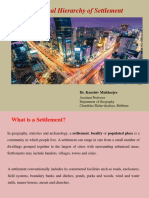Regional and Vernacular Built Environments in India R2021
Regional and Vernacular Built Environments in India R2021
Uploaded by
R SamuelCopyright:
Available Formats
Regional and Vernacular Built Environments in India R2021
Regional and Vernacular Built Environments in India R2021
Uploaded by
R SamuelOriginal Title
Copyright
Available Formats
Share this document
Did you find this document useful?
Is this content inappropriate?
Copyright:
Available Formats
Regional and Vernacular Built Environments in India R2021
Regional and Vernacular Built Environments in India R2021
Uploaded by
R SamuelCopyright:
Available Formats
AR3401 – REGIONAL AND VERNACULAR BUILT ENVIRONMENTS IN INDIA- ECA
AR3401 – REGIONAL AND VERNACULAR BUILT ENVIRONMENTS IN INDIA
B.Arch II Year IV Semester
ECA – Ar Sowmyaa C -2023-24 1
AR3401 – REGIONAL AND VERNACULAR BUILT ENVIRONMENTS IN INDIA- ECA
SYLLABUS
OBJECTIVES
To introduce the nature of evolution/ determinants of human settlements. To give an understanding
of regional manifestations in settlements and architecture as evolving from contextual forces. To give
familiarity to the methods and approaches for the study of regional/ vernacular built environment. To
study the important manifestations of regional/ vernacular architecture and settlements in different
regions of India.
UNIT I HUMAN SETTLEMENTS AND THEIR DETERMINANTS
Determinants of morphology of human settlements – climate, culture, socio-economic aspects,
geography, etc, Differentiating between rural and urban settlements. Overview of settlement
evolution in India. Relation between settlement morphology and architecture. Discussion of the terms
traditional architecture, regional architecture, indigenous architecture, vernacular architecture, etc.,
UNIT II STUDY OF VERNACULAR/ REGIONAL ARCHITECTURE
Vernacular/ regional architecture as a process and responsive design. Concepts, approaches, survey
and study of vernacular/ regional architecture -aesthetic, architectural, anthropological, etc., General
aspects to be studied in vernacular/ regional architecture of India –climatic response, forms, spatial
planning, socio-cultural aspects, symbolism, colour, art, materials of construction and construction
technique, etc.,
UNIT III SETTLEMENT MORPHOLOGY AND REGIONAL ARCHITECTURE OF GUJARAT AND
RAJASTHAN
Determinants and morphology of rural and urban settlements in Gujarat. Vernacular/ regional
architecture of Gujarat as particular productions. Determinants and morphology of rural and urban
settlements in Rajasthan. Vernacular/ regional architecture of Rajasthan as particular productions.
UNIT IV SETTLEMENT MORPHOLOGY AND REGIONAL ARCHITECTURE OF KASHMIR AND
BENGAL
Determinants and morphology of settlements in Kashmir. Vernacular/ regional architecture of
Kashmir as particular productions. Determinants and morphology of settlements in Bengal.
Vernacular/ regional architecture of Bengal as particular productions. Colonial and modern influences.
UNIT V SETTLEMENT MORPHOLOGY AND REGIONAL ARCHITECTURE OF TAMILNADU AND
KERALA
Determinants and morphology of settlements in Kerala. Vernacular/ regional architecture of Kashmir
as particular productions. Determinants and morphology of rural and urban settlements in Tamil
Nadu. Vernacular/ regional architecture of Tamil Nadu as particular productions. Colonial and modern
influences.
ECA – Ar Sowmyaa C -2023-24 2
AR3401 – REGIONAL AND VERNACULAR BUILT ENVIRONMENTS IN INDIA- ECA
OUTCOME
An understanding of the built environment as a process and knowledge of its determinants. Ability to
analyse built environment through the knowledge of approaches to its study. Knowledge of
settlement morphologies and regional/ vernacular architecture in specific regions of India.
TEXTBOOKS
1. Bernard Rudofsky, 'Architecture without Architects', University of New Mexico Press, 1987.
2. Paul Oliver, 'Encyclopedia of Vernacular Architecture of the World', Routledge, 2007.
3. Amos Rapoport, 'House, Form and Culture', Prentice Hall Inc. 1969.
4. Carmen Kagal, 'Vistara- The Architecture of India', The Festival of India, 1986.
REFERENCES
1. Kosambi D.D, 'The Culture and Civilisation of Ancient India in Historical Outline', Vikas,1997.
2. R W Brunskill, 'Illustrated Handbook on Vernacular Architecture', Faber and Faber, 2000.
3. V.S. Pramar, 'Haveli – Wooden Houses and Mansions of Gujarat', Mapin, 1989.
4. Kulbushanshan Jain and Minakshi Jain, 'Mud Architecture of the Indian Desert', Aadi Centre,
Ahmadabad, 1992.
5. G.H.R. Tillotson, 'The Tradition of Indian Architecture: Continuity, Controversy, Change since 1850',
Oxford University Press, Delhi, 1989.
6. S. Muthiah et al, 'The Chettiar Heritage', Chettiar Heritage, 2017.
7. Weber. W and Yannas. S, 'Lessons from Vernacular Architecture', Routledge, 2014.
ECA – Ar Sowmyaa C -2023-24 3
AR3401 – REGIONAL AND VERNACULAR BUILT ENVIRONMENTS IN INDIA- ECA
UNIT I HUMAN SETTLEMENTS AND THEIR DETERMINANTS
Determinants of morphology of human settlements
A populated place or settlements refers to community where people reside. Settlements can vary in
size, from a small group of houses to large cities with extensive urbanized areas. These communities
can consists of hamlets, villages, towns and cities. A settlement reflects the socioeconomic conditions
and environmental limitations of given area, encompassing both physical structures like houses and
the people who live there. It represents the social, historical, cultural and religious aspects of human
life within a specific geographic environment.
The development of settlements can be traced back to nomadic herders who eventually settled in one
place due to the growth of families and the need for a stable living environment. As a result, villages
began to form, often centered around agricultural activities.
Some villages accumulated non agricultural surpluses, leading to the development of ‘mandis’ or
‘marketplaces’. Transportation routes connected these Mandis, giving rise to urban settlements.
RURAL SETTLEMENT VS URBAN SETTLEMENT:
CRITERIA RURAL SETTLEMENT URBAN SETTLEMENT
Morphology Consists of agricultural Characterised by tall buildings,
landscapes broad roads, administrative
centres and recreational spaces.
Activity Agriculture, forestry, mining, Non Agriculture, Manufacturing
fishing
Demography Lower population with scattered High population with compact
settlement living spaces
Population Less than 5000 Greater than 5000
Population density Less than 400 persons/ sq.km Greater than 400 persons/sq.km
Run By Gram Panchayats Municipality, Cantonment Board,
Corporation
RURAL SETTLEMENT :
Rural settlements consists of disorganized clusters of closely connected houses with poor ventilation
and inadequate sewage and drainage systems. The roads in these settlements are often winding and
not well planned, sometimes ending abruptly at houses.
Rural settlements not only encompass villages but also the surrounding agricultural fields, forestry
areas and livestock raising land that are functionally integrated with the village. These communities
are characterized by strong social bonds and a high degree of cohesion among residents, reflecting a
powerful centripetal force due to the close relationships between people. Both the physical layout
and social structure of rural settlements contribute to their overall makeup.
ECA – Ar Sowmyaa C -2023-24 4
AR3401 – REGIONAL AND VERNACULAR BUILT ENVIRONMENTS IN INDIA- ECA
They are made up of the village itself, along with agricultural land, forestry and livestock-raising areas.
These settlements are a reflection of the socio-economic aspirations of the people, their adaptability,
the historical development of a living civilization and their economic functionality.
HAMLET
A hamlet is a small human settlement. A hamlet is considered smaller than a village. A hamlet differs
from a village in having no commercial premises.
VILLAGE
A village is a clustered human settlement or community, larger than a hamlet but smaller than a town
with a population ranging from a few hundred to few thousand.
RURBAN
Rural + Urban. Transitional phase in between rual and urban settlements. Run by Gram Panchayets.
Population is more than 5000 but less than 10,000.
TOWN
A town is a medium-sized human settlement. Towns are generally larger than villages but smaller than
cities, though the criterial which constitute them vary considerably in different parts of the world.
Large town consists of 20,000 to 1 Lakh People. Town consists of 5,000 to 20,000 people.
CITY
A city is a large human settlement. Cities generally have extensive systems for housing, transportation,
sanitation, utilities, land use and communication. City consists of 1 Lakh to 3 Lakh Population. Large
City consist of 3 Lakh to 1 million population.
METROPOLIS
A metropolis is a large city or conurbation which is a significant economic, political and cultural center
for a country or region. An important hub for regional or international connections, commerce and
communications. Mother city of a colony having minimum population 1 million to 3 million and
conurbation from 3 million to 10 million people.
ECA – Ar Sowmyaa C -2023-24 5
AR3401 – REGIONAL AND VERNACULAR BUILT ENVIRONMENTS IN INDIA- ECA
MEGALOPOLIS
The term was used by Patrick Geddes in his 1915 book Cities in Evolution. Jean Gottmann popularised
this term in 1961. A megalopolis (sometimes called a megapolis, also megaregion or supercity) is
typically defined as a chain of roughly
adjacent metropolitan areas, which may
be somewhat separated or may merge
into a continuous urban region.
Megalopolis is derived from Greek :
megas meaning great and polis meaning
city, therefore literally a ‘great city’. This
term is closer in meaning to megacity.
Gottmann defined its population as 25
million. Doxiadis defined a small
megalopolis a similar cluster with a
population of about 10 million.
PRIMARY CITY
A primary city (Latin : ‘prime, first rank) is the largest city in its country or region, disproportionately
larger than any other in the urban hierarchy. First proposed by geographer Mark Jefferson in 1939. He
defines a primary city as being “at least twice as large as the next largest city and more than twice as
significant’. Among the best known examples of primary cities are London and paris.
MORPHOLOGY OF RURAL SETTLEMENT
Morphology refers to the internal structure or the constructional plan of a village which includes the
layout of streets and roads, arrangement of houses, pattern of housing, geometrical size and shape of
village and agricultural fields, location of either the water body, religious site or the house of the village
headman.
Rural Morphology include Physical Morphology and Social Morphology.
PHYSICAL MORPHOLOGY
Physical Morphology includes the study of the relationship between the following:
Road to Lane relationship It includes how roads are connected to lanes.
Lane to Lane relationship It is description of geometrical arrangement of lanes. How are they
connected to each other and ending at what points. In Indian villages, lanes are extremely narrow
meandering and ending abruptly. This shows unplanned character of Indian villages. In UK, cruciform
villages have all the lanes cutting across 90 degree, because they are planned villages.
Lane to House relationship Geometry of lanes determines the arrangement of houses because houses
grow along lanes. In India, lanes are largely unplanned and arrangement of houses determines the
lane type.
ECA – Ar Sowmyaa C -2023-24 6
AR3401 – REGIONAL AND VERNACULAR BUILT ENVIRONMENTS IN INDIA- ECA
House to House relationship Physical morphology is also determined by the spacing between the
houses. In clustered villages, houses are unevenly spaced or they have wall to wall arrangement.
Houses are hardly according to geometrical plan and their average height is variable. There is
clustering of houses based on social structure / cast system. House type can range from Pucca to
kutcha and in older parts of the villages, ventilation is closed to the roof (depends on the whether
village is developed or not)
SOCIAL MORPHOLOGY
It refers to the social structure of a village which is based on cast or class. In Indian villages, caste
hierarchy is reflected in the morphology of villages. Social factors like division of work, untouchability,
social prohibition over the work of women and lower casts had all led to a distinct social morphology
of rural settlements from urban ones.
The following factors affect the following morphological character of villages :
Arrangement of buildings, Pattern of streets and fields, Functional characteristics of settlement.
Eg: the houses of higher cast people like Brahmins and Rajputs would be large and people from the
ower cast would have huts, kutcha houses with cattle.
The intermediate regions of rural settlement comprise of the people of service casts like Ahirs, Jats,
Loth etc. Cast based hamlets at times emerge. These are closely linked with centre under the jajmani
system (inter cast cooperation like higher cast people requiring lower cast people for some specific
work) and act like unit.
DOXIADIS CLASSFICATION OF RURAL MORPHOLOGY
Earliest attempt to classify rural morphology was done by Doxiadis. He classified rural morphology
into four sectors :
1. Homogenous sector / Village core
2. Transitional Zone
3. Circulatory Part
4. Special Part
ECA – Ar Sowmyaa C -2023-24 7
AR3401 – REGIONAL AND VERNACULAR BUILT ENVIRONMENTS IN INDIA- ECA
HOMOGENOUS SECTOR / VILLAGE
Central part of the Village
Religious site, water body or Zamindar / Village Headmans’s house or community land.
Surrounded by own caste man of village Zaindar
Most densely populated region and congested part of the village reflecting patriarchal society
and security concerns.
TRANSITIONAL ZONE
This part is occupied by the village servicemen. Eg. Goldsmith, Blacksmith, Milkman, Weavers
etc.,
This Zone is attached with the core of the village where middle caste people are mixed with
poor upper caste people.
This zone is also known as Artisans zone.
CIRCULATORY PART
It is the outer periphery of the village where new houses and settlers have been migrated or
settled outward due to congestion of the core
Thus, this zone has mixed land use in terms of social structure
SPECIAL PART
It was occupied by landless labours outside the village close to farmlands because of work
opportunities on field and social segregations.
They are usually the people from the lower castes.
ECA – Ar Sowmyaa C -2023-24 8
You might also like
- Rural VS Urban Characteristics FinalDocument14 pagesRural VS Urban Characteristics FinalVarunNo ratings yet
- Urban & Rural SettlementsDocument8 pagesUrban & Rural SettlementsSomi SareenNo ratings yet
- Settlement GeeographyDocument25 pagesSettlement GeeographyLucky SinghNo ratings yet
- Forms of HSDocument18 pagesForms of HSSuruthi ATKNo ratings yet
- Human Settlements and PlanningDocument12 pagesHuman Settlements and PlanningtinabhuvanNo ratings yet
- HUMAN SETTLEMENTS INDIA DocxDocument7 pagesHUMAN SETTLEMENTS INDIA DocxSarbani ChakrabortiNo ratings yet
- Characteristics of RurbanizationDocument2 pagesCharacteristics of RurbanizationEditor IJTSRDNo ratings yet
- © Ncert Not To Be Republished: Human SettlementsDocument8 pages© Ncert Not To Be Republished: Human Settlementskrishnendu_balNo ratings yet
- HSP - 2017 - UNIT 2 - B.ArchDocument81 pagesHSP - 2017 - UNIT 2 - B.ArchHasiba BarisaNo ratings yet
- History and GeographyDocument7 pagesHistory and GeographyJudy ann ColumbinoNo ratings yet
- Village in India Myths and Realities Author Vishwa AnandDocument5 pagesVillage in India Myths and Realities Author Vishwa AnandM. Shehryar KhanNo ratings yet
- Human Settlement and PlanningsDocument53 pagesHuman Settlement and PlanningsAshwini AnandNo ratings yet
- Day 1 Enp Cullo 03 Human Settlements City Growth Spatial PatternsDocument44 pagesDay 1 Enp Cullo 03 Human Settlements City Growth Spatial PatternsEdward Aguirre PingoyNo ratings yet
- Topic 3RD Human SettlementsDocument4 pagesTopic 3RD Human SettlementsVanshika BajajNo ratings yet
- Chapter Five Social Philosophy of Life in NepalDocument12 pagesChapter Five Social Philosophy of Life in NepalSushmita AdhikariNo ratings yet
- Urban Vs RuralDocument4 pagesUrban Vs RuralHawaid AhmadNo ratings yet
- Urbanisation: Urban, Rural and It's Connotations Issues of Urbanisation Urbanisation in IndiaDocument30 pagesUrbanisation: Urban, Rural and It's Connotations Issues of Urbanisation Urbanisation in IndiaGeetanjali Bhoite ChavanNo ratings yet
- Settlement Geography Sem II, Paper V PDFDocument38 pagesSettlement Geography Sem II, Paper V PDFHema sundariNo ratings yet
- Urban Vs RuralDocument4 pagesUrban Vs Ruralyuktha N GowdaNo ratings yet
- PLB mgg9 - Cities PDFDocument25 pagesPLB mgg9 - Cities PDFellya rahmahNo ratings yet
- Difference Between Urban and RuralDocument4 pagesDifference Between Urban and RuralJazib KhanNo ratings yet
- Unit 1Document51 pagesUnit 1subhikshaNo ratings yet
- Difference Between Urban and Rural (With Comparison Chart) - Key DifferencesDocument3 pagesDifference Between Urban and Rural (With Comparison Chart) - Key DifferencesShailesh Kumar IyerNo ratings yet
- Main Features of Rural SocietyDocument8 pagesMain Features of Rural SocietyKarina Vangani100% (2)
- Building Economics and Sociology: Assignment IiDocument11 pagesBuilding Economics and Sociology: Assignment Iibunny depaNo ratings yet
- Rural Settlement in IndiaDocument3 pagesRural Settlement in Indiasharmaatul13No ratings yet
- Urban Rural Continuum - : The Merging of Town and CountryDocument10 pagesUrban Rural Continuum - : The Merging of Town and CountryVishnu Rajeev0% (1)
- Evolution of SettlementsDocument7 pagesEvolution of SettlementsSwati ThakurNo ratings yet
- Unit I IntroductionDocument19 pagesUnit I IntroductionArunagiri Senthil KumarNo ratings yet
- Classification of VillagesDocument4 pagesClassification of Villagesdj hackerNo ratings yet
- Damodaram Sanjivayya National Law Universityvisakhapatnam, A.P., IndiaDocument32 pagesDamodaram Sanjivayya National Law Universityvisakhapatnam, A.P., IndiaKranthi Kiran TalluriNo ratings yet
- Difference Between Urban and RuralDocument2 pagesDifference Between Urban and RuralAnthony Jay CombateNo ratings yet
- Unit 13Document24 pagesUnit 13Dhyeý VarsadiyáNo ratings yet
- Unit 3Document13 pagesUnit 3msodagar990No ratings yet
- Human Settlement 3 PDFDocument8 pagesHuman Settlement 3 PDFPooja Jain0% (1)
- Urbandesignar3901chapter1 230912100320 856df3deDocument57 pagesUrbandesignar3901chapter1 230912100320 856df3deAbdul AzizNo ratings yet
- Urban Geography CompilationDocument11 pagesUrban Geography CompilationAlbert Francisco OstayaNo ratings yet
- Human Societies: Module - 3Document14 pagesHuman Societies: Module - 3A2 D2No ratings yet
- Basic Principles & Components of Ekistics: Made by Ashima Mathur Harshika Sharma Nabha JoshiDocument20 pagesBasic Principles & Components of Ekistics: Made by Ashima Mathur Harshika Sharma Nabha JoshiAnkita goelNo ratings yet
- Settlement GeographyDocument57 pagesSettlement GeographyniviNo ratings yet
- Jaat Architecture, Mirror of The Past and Shadow of Future: Monali Wankar Chakraborty and Bikramjit ChakrabortyDocument10 pagesJaat Architecture, Mirror of The Past and Shadow of Future: Monali Wankar Chakraborty and Bikramjit ChakrabortyAkshitaNo ratings yet
- Rural Vs Urban SettlementDocument3 pagesRural Vs Urban SettlementEdhelmira TarapeNo ratings yet
- INICIA BIL - 2ESO GEO LA UnitDocument20 pagesINICIA BIL - 2ESO GEO LA UnitzeusNo ratings yet
- Urban PlanningDocument17 pagesUrban PlanningFrianne FrondarinaNo ratings yet
- Presentation PDFDocument69 pagesPresentation PDFAr Arun Antony AlosciousNo ratings yet
- Legy 202Document6 pagesLegy 202Omkar WalunjNo ratings yet
- Lecture 1Document18 pagesLecture 1Mohd JubairNo ratings yet
- Pranay Socio 2 CompleteDocument41 pagesPranay Socio 2 CompletePranay BhardwajNo ratings yet
- Compliled Notes HSPDocument41 pagesCompliled Notes HSPhemnath R.A.No ratings yet
- Human Settlements Planning: ObjectivesDocument16 pagesHuman Settlements Planning: ObjectiveshariNo ratings yet
- Functional Hierarchy of SettlementDocument17 pagesFunctional Hierarchy of SettlementKafayat ShahNo ratings yet
- Socio Economic Profile of AurangabadDocument72 pagesSocio Economic Profile of AurangabadShrinath DeshpandeNo ratings yet
- 10 - Chapter 1 PDFDocument82 pages10 - Chapter 1 PDFVanila MehtaNo ratings yet
- MYP4 U2 Human SettlementsDocument10 pagesMYP4 U2 Human SettlementsshravyasharmaNo ratings yet
- Human Settlement and PlanningDocument49 pagesHuman Settlement and PlanningNavin Raj Kumar -No ratings yet
- Introduction To Human Settlements and Urban Form DeterminantsDocument84 pagesIntroduction To Human Settlements and Urban Form DeterminantsAbhishek Venkitaraman Iyer100% (44)
- Rural Development: Adhiparasakthi Engineering College V.Gomathi Iii-EceDocument5 pagesRural Development: Adhiparasakthi Engineering College V.Gomathi Iii-EceGomathiNo ratings yet
- On Farms and Rural Communities: An Agricultural Ethic for the FutureFrom EverandOn Farms and Rural Communities: An Agricultural Ethic for the FutureNo ratings yet
- Welcome to the Urban Revolution: How Cities Are Changing the WorldFrom EverandWelcome to the Urban Revolution: How Cities Are Changing the WorldRating: 4 out of 5 stars4/5 (7)
- UNIT 1 INTRODUCTION TO SITE AND SITE SURVEYING (Autosaved)Document242 pagesUNIT 1 INTRODUCTION TO SITE AND SITE SURVEYING (Autosaved)R SamuelNo ratings yet
- Unit 1 Session 3 24 8 20Document18 pagesUnit 1 Session 3 24 8 20R SamuelNo ratings yet
- Notes On: Dr. Thomas L. ConstableDocument45 pagesNotes On: Dr. Thomas L. ConstableR SamuelNo ratings yet
- Its Your BloodDocument1 pageIts Your BloodR SamuelNo ratings yet































































